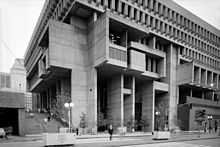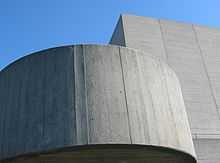Béton brut

Boston City Hall, an example of brutalism using béton brut

Detail of the Royal National Theatre showing the grain of the formwork
Béton brut (French pronunciation: [betɔ̃ bʁy], raw concrete) is architectural concrete left unfinished or roughly-finished after pouring and left exposed visually. The imprint of the wood or plywood formwork used for pouring is usually present on the final surface.
The use of béton brut was pioneer by Auguste Perret and other modern architects. It was used in such buildings as Unité d'Habitation in the early part of the twentieth century. It flourished as a part of the brutalist architecture of the 1960s and 70s. This largely gave way to structural expressionism as steel structures became more advanced and viable. Wood-imprinted concrete is still very popular in landscaping especially in some of the western European countries.
Examples
- University of Illinois at Chicago (East side of campus designed by Walter Netsch of Skidmore, Owings & Merrill)
- The Evergreen State College
- Sainte-Bernadette-du-Banlay church, Nevers, France, architect Claude Parent
- Boston City Hall
- Royal National Theatre, London
- Unité d'Habitation
- Habitat 67
- The main branch of the Orange County Library System in Florida
- Runways at Frankfurt Airport
- Dewan Tunku Cancelor at University of Malaya